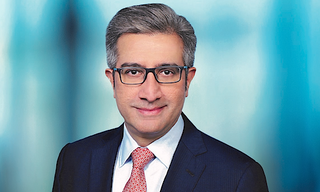UBS and Credit Suisse went head-to-head with quarterly results on Friday. What did the comparison reveal? finews.com breaks down the essential points.
1. Share Price Messages
Investors sent UBS and Credit Suisse very different messages following the bank's results. While UBS slid sharply, stockholders rewarded Credit Suisse – a clear sign that Tidjane Thiam holds investor favor at the moment simply because his bank has more to fix. Meanwhile, UBS boss Sergio Ermotti, who has made no secret of his irritation over UBS' shares not being valued more richly, is left to steam as investors shun a solid, stable growth story.
Credit Suisse also commands the lead over UBS in a year-to-date comparison, with an 11 percent gain compared to roughly half that for UBS.
2. Comfortable Cushion
Investors are breathing a sigh of relief over Credit Suisse: after finally asking shareholders for 4 billion francs, the bank is now comfortably over new capital rules that come into effect in 2019. At 13.3 percent, it is actually close to UBS levels. UBS of course began bolstering its capital after surfacing from the 2008-9 crisis which nearly felled the bank.
Surprisingly, UBS’ capital actually edged lower in the quarter for the first time in recent memory, to 14.8 percent from 15.6 percent. Why? It is using more risk-weighted assets and likely lending more, as its leverage ratio also dropped.
To be sure, Credit Suisse is out of the danger zone while its larger rival is still flush with capital, but UBS owes investors an explanation for the sudden drop.
3. Net New Money: Imperative vs Luxury
How UBS and Credit Suisse approach net new money is hugely revealing. UBS hoovered up 28.5 billion Swiss francs in the first six months in all its wealth divisions, but this is actually 10 billion francs less than one year ago. As of June, UBS manages 2.2 trillion francs – still the largest wealth manager in the world.
Considerably smaller Credit Suisse took in 22.8 billion francs, which is 12 percent more than in the first six months of last year. In total, Credit Suisse now manages 716 billion francs on behalf of its wealthy clients.
The comparison shows that Credit Suisse isn't afraid to be more assertive in attracting and absorbing new funds – because it has to if it wants to make a go of its wealth management-centric strategy. By contrast, UBS is already pulling back, with private bank head Juerg Zeltner effectively turning down money if it isn't profitable and Ermotti emphasizing the bank's «quality over quantity» maxim, as he did again on Friday in a «Bloomberg» interview in conjunction with the results.
4. Cost Cuts: Same Same, but Different
Employees at both banks are weary of about cost cuts. Pressure on Credit Suisse is higher, simply because CEO Thiam is still working through the morass left by his predecessor, Brady Dougan. A quarterly comparison of the two reveals that they are going about their cost cuts very differently. Thiam slashed total spending by 5 percent, and the bank is on track with its cutting goals. UBS trimmed by 3 percent.
The big difference? Credit Suisse is mainly cutting personnel expenses – jobs – while UBS is pruning its general expenses instead. UBS' past investments in information technology infrastructure may be helping here.
5. Credit Suisse's Swiss Boot Camp
For both, the Swiss business represents heart and lungs. But Credit Suisse is showing itself more nimble in responding to conditions in a saturated, overbanked and stagnant market. Why? Credit Suisse's Thomas Gottstein has a far better grip on the unit's costs than UBS.
There, his former Commerzbank CEO Martin Blessing is grappling with a toxic mix of higher regulatory costs as well as new investments. Gottstein has managed a cost-income ratio of 58 percent while Blessing has only managed to lower his to 62 percent, from 65 percent year-ago.
6. Credit Suisse's Wall Street Cred
This quarter's focus was firmly on private banking, which plays into CEO Thiam's strategy to bolster business with the world's wealthy and pare back riskier Wall Street income. A direct comparison shows that Thiam has left a lot of investment banking in Credit Suisse: markets and advisory contributed a whopping 40 percent of the bank's overall net revenues. At UBS, the figure stood at just 27 percent.
Credit Suisse remains more strongly exposed to market vagaries than UBS – something which showed in the second quarter as equity revenue crumbled amid lack of client demand.
7. Problem Child Woes
Asset management remains a problem child for both big banks, if not a particularly pressing one in the scheme of other activities. Under Ulrich Koerner, UBS has elected for a supermarket approach of mixing passing and active strategies and tacking on boutiques like O’Connor. The result after more than three years? His 1 billion pre-tax profit target looks like a pipe dream. With a cost-income ratio of 72.7 percent, the notoriously shrewd cost-cutter Koerner is also well over what he wants to be spending, compared to a 70 percent target.
Credit Suisse has opted for a niche strategy, keeping things it is good at and offloading others, like fund management. Is it working? Yes, partly – though arguably Credit Suisse is paying more for the privilege of doing so. Its cost-income ratio is a horrific 79.8 percent – mostly because of banker pay.
What does this tell us? Despite their protestations, asset management isn’t a core skill at either bank, and the pressure on profits is only set to rise, as finews.com has written previously.


























